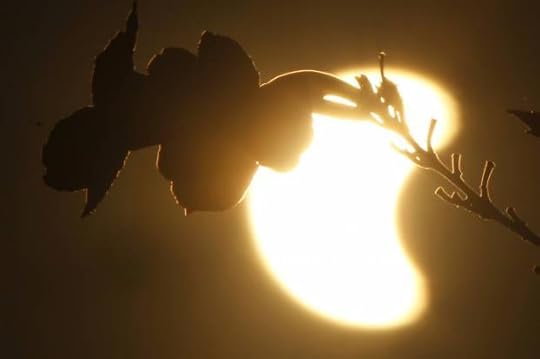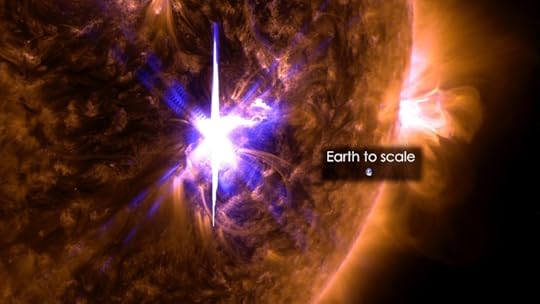Helen H. Moore's Blog, page 304
September 11, 2017
A radical for our time: Benjamin Lay, the Quaker dwarf abolitionist you didn’t learn about in class

Benjamin Lay painted by William Williams (Credit: Wikimedia)
The Quaker dwarf Benjamin Lay (1682-1759) was the first revolutionary abolitionist. He demanded an end to slavery and therefore radical change in all societies where it had a significant presence, and he anchored abolition in a new way of life, without human and animal exploitation, based on the “innocent Fruits of the Earth.” He lived in a cave, ate only fruits and vegetables, championed animal rights, and refused to consume any article produced by slave labor. The first person to call him a revolutionary was Benjamin Rush, Philadelphia physician and signer of the Declaration of Independence, in 1790, the beginning of a decade that would see the Atlantic in flames, from Paris to Belfast to Port-au-Prince. Rush explained that Lay sowed “the seeds of a principle which bids fair to produce a revolution in morals, commerce, and government, in the new, and in the old world.” Lay the commoner would have liked the planting metaphor, and Lay the sailor would have liked the transatlantic reach.
Born to a Quaker farm family in Copford, a small village in Essex, England, Lay moved as a young man to London and went to sea, relocated to Barbados at age thirty-six, and moved to Philadelphia at age fifty. He entered an urban trade and then a global seafaring culture between roughly 1700 and 1714, became a convinced abolitionist after his encounter with slavery between 1718 and 1720, and devoted himself to a new kind of commoning from the 1730s through the late 1750s. To a foundation of Quaker radicalism he added the egalitarianism and cosmopolitanism of seafaring culture, the life-and-death struggles of African America, and the environmentally friendly ways of vegetarianism. He talked with and learned from enslaved people in Barbados. He fed the hungry and preached an end to slavery, earning the wrath of the master class. He denounced ministers – Quakers and others – who did not live up to his standards. He spoke truth to power, shaming and defying slave traders and keepers. He dared to live in a new way based on an ethical relationship to all living things. He applied evolving radical principles to all aspects of his life, changing himself as he changed the world. He chose what he considered the best practices from multiple social worlds as he tried to create a new one. He wrote and lived an eighteenth-century “theology of liberation.”
Lay is little known among historians. He appears occasionally in histories of abolition, usually as a minor, colorful figure of suspect sanity. By the nineteenth century he was regarded as “diseased” in his intellect and later as “cracked in the head.” To a large extent this image has persisted in modern histories. Indeed David Brion Davis, a leading historian of abolitionism, condescendingly called Lay a mentally deranged, obsessive “little hunchback.” Lay gets better treatment by amateur Quaker historians, who include him in their pantheon of antislavery saints, and by the many excellent professional historians of Quakerism. He is almost totally unknown to the general public.
Lay was better known among abolitionists than among their later historians. The French revolutionary Jacques Pierre Brissot de Warville gathered stories about him almost three decades after his death, during a visit to the United States in 1788. Brissot wrote that Lay was “simple in his dress and animated in his speech; he was all on fire when he spoke on slavery.” In this respect Lay anticipated by a century the abolitionist leader William Lloyd Garrison, who was also “all on fire” about human bondage. When Thomas Clarkson penned the history of the movement that abolished the slave trade in Britain, in 1808, a moment of triumph for that country, he credited Lay, who had “awakened the attention of many to the cause.” Lay possessed “strong understanding and great integrity,” but was “singular” and “eccentric.” He had, in Clarkson’s view, been “unhinged” by cruelties he observed in Barbados between 1718 and 1720. When Clarkson drew his famous graphic genealogy of the movement, a riverine map of abolition, he named a significant tributary “Benjamin Lay.” On the other side of the Atlantic, in the 1830s and 1840s, more than seventy years after Lay’s death, the American abolitionists Benjamin Lundy and Lydia Maria Child rediscovered him, republished his biography, reprinted an engraving of him, and renewed his memory within the movement.
Lay is not the usual elite subject of biography. He came from a humble background and was poor most of his life, by occupation and by choice. He lived, he explained, by “the Labour of my Hands.” He was also considered a philosopher in his own day, much like the ancient Greek Diogenes, the former slave known for speaking truth to power. (He refused Greek nationality and insisted that he was, rather, “a citizen of the world.”) Lay lived a mobile, far-flung life, in England, Barbados, Pennsylvania, and on the high seas in-between, all of which shaped his cosmopolitan thinking. Unlike most poor people, he left an unmediated record of his ideas, most significantly in his own book, “All Slave-Keepers That Keep the Innocent in Bondage, Apostates,” a rich and remarkable body of evidence by any measure.
A central tactic in Lay’s militant attack on slavery was the guerilla theater he practiced against slave-owners. Lay advocated incessantly for emancipation, in some cases on behalf of specific individuals he knew. One such person was a “negroe girl” — her name has not survived in the evidence — who was owned by Lay’s Quaker neighbors in Abington, Pennsylvania. Lay argued repeatedly with the man and woman about the iniquity of keeping slaves, insisting that the girl be freed, but to no avail. The couple not only kept her in bondage; they justified the practice. Lay explained to them the “wickedness” of the slave trade, emphasizing how it separated children from their parents. Soon after, Lay encountered the six-year-old son of the couple a short distance from their farm. He invited him to his cave about a mile away and entertained the boy all day inside, out of view.
When evening came on, Lay observed the boy’s father and mother running toward his dwelling. He advanced and met them, “enquiring in a feeling manner, ‘what is the matter?’” The parents replied in anguish, ‘Oh Benjamin, Benjamin! our child is gone, he has been missing all day.’” Lay listened with sympathy, paused, and said, “Your child is safe in my house.” Then he explained why he was there: “You may now conceive of the sorrow you inflict upon the parents of the negroe girl you hold in slavery, for she was torn from them by avarice.” Lay expressed a simple, profound message central to Quakerism and indeed to all Christianity: do unto others as you would have them do unto you.
Lay’s radicalism was a rope of five strands: he was a Quaker, philosopher, sailor, abolitionist, and commoner. As a free thinker he drew on a wide variety of books and intellectual traditions, combining them creatively to serve his own values and purposes. He was first and foremost an antinomian radical — someone who believed that salvation could be achieved by grace alone and that a direct connection to God placed the believer above man-made law. Lay combined Quakerism with abolitionism and other radical ideas and practices that were uncommon for his time and rarely thought to be related: vegetarianism, animal rights, opposition to the death penalty, environmentalism, and the politics of consumption. For Lay these beliefs and practices were all part of a consistent, integrated, ethical worldview — one that could save a planet desperately in need of salvation. He showed that multiple forms and traditions of radicalism could all be part of the same consciousness. He believed that abolition must inform a revolutionary revaluation of all life, premised on a rejection of the capitalist values of the marketplace. Benjamin Lay was, in several ways, a curiously modern man whose story has never been fully or properly told. He is a radical for our time.
In the aftermath of numerous successful abolition movements, now that almost everyone agrees that slavery was, and remains to this day, morally wrong, it is not easy to recover the profound hostility Lay encountered for espousing antislavery beliefs in the early eighteenth century. Lay himself noted how people flew into rages when they heard him speak against bondage. They ridiculed him; they heckled him; they laughed at him. Many dismissed him as mentally deficient and somehow deranged as he opposed the deep “common sense” of the era. The scorn was based in economic interest and racial prejudice but also in bias against him as a little person. Each reinforced the other in cruelty and rancor.
As both an abolitionist and a dwarf, Lay withstood pressure and constant derision for decades, but he never sank, declined, flinched, or retreated. At the same time his determination and conviction made him an awkward and difficult person, to say the least. He was loving to his friends, but he could be a holy terror to those who did not agree with him. He was aggressive and disruptive. He was stubborn, never inclined to admit a mistake. His direct antinomian connection to God made him self-righteous and at times intolerant. The more resistance he encountered, or, as he understood it, the more God tested his faith, the more certain he was that he was right. He had reasons both sacred and self-serving for being the way he was. He was sure that these traits were essential to defeat the profound evil of slavery.
The ill will expressed toward Lay in Barbados and Pennsylvania came from both above and below — from political and religious leaders and from ordinary people, all of whom supported the institution of slavery in one way or another. To make this point, Lay’s biographer Roberts Vaux quoted Rome’s great lyric poet, Horace, of whom Lay would certainly have approved, as he loved the writers of antiquity:
The just man who is resolute
will not be turned from his purpose
either by the rage of the crowd or
by an imperious tyrant.
It took fortitude and courage to face the kind of opposition that confronted Benjamin Lay over the last forty years of his life. Fortunately for him, and for posterity, those virtues were never in short supply. He demonstrated the power of saying no to slavery. His life is a story of fearlessness in that cause.
Gary Numan on Trump: “He could be the thing that brings about the end of everything”

Artist Gary Numan may not be American, but he is still deeply concerned about the state of American politics. His new album, which is his 22nd studio album, is titled “Savage (Songs from a Broken World)” and releases September 15. The album is set in an apocalyptic, post-global warming future, one he imagines isn’t too far off now that Donald Trump is in charge and has announced he is withdrawing from the Paris climate accord.
Numan spoke with Salon’s Amanda Marcotte on “Salon Talks,” about the magnitude of this moment: a Trump presidency alongside aggressive climate change.
Here are some highlights from their conversation. Watch the video above for more on Numan’s thoughts on Trump and the apocalypse, and tune into the full “Salon Talks” episode here.
Watch “Salon Talks” daily at noon ET / 9 a.m. PT and 4 p.m. ET /1 p.m. PT, streaming live on Salon and on Facebook.
On Donald Trump and the future of the world:
It could be him. He could be the thing that brings about the end of everything. And to be alive in that moment, is extremely frightening. Imagine being alive when the end of the world starts.
I’m sure that in a few years time he’ll be gone. But for now, there’s a very real possibility that all of that good work is going to be undone. It will become an unstoppable thing.
On if Trump can be stopped:
I’m sure that somewhere there are people with a spine that will actually stand up. I’m surprised at so far—at the lack of resistance amongst people that could really resist and do something about it and just say ‘c’mon, you can’t do that.’ There’s a lot of people saying ‘oh, that’s a bit naughty, isn’t it?’ No names mentioned at all.
It’s not enough.
This HD Kodak security camera is over half off

It’s hard to keep an eye on everything at once — so whether you have to step out for an errand, or are leaving for a few days of vacation, it helps to have a home security system to keep a little peace of mind while you’re away. Rather than going all in on an ADT system, the Kodak 180° Panoramic HD WiFi Security Camera offers a convenient, budget-friendly way to keep a handle on what’s going on in your house, whether you’re in it or not.
This Kodak video monitor features an expansive 180º field of view so you can see an entire room, whether you just want to watch out for your new puppy or you have prized possessions you want to protect. The camera features Wide Dynamic Range (WDR) to automatically correct scenes with extreme lighting, and a detachable USB camera for greater mobility.
This sleek camera includes a whole host of automation and detection features, plus you can playback recorded motion-triggered video clips post-recording. They’re stored in the cloud for 24 hours. You can even stream the feed live to the device of your choice, or use the two-way audio talk back feature to communicate with anyone camera-side.
Keep your favorite things (or loved ones, of course) safe. Usually $149.99, you can get this Kodak 180° Panoramic HD WiFi Security Camera for $69.99 — that’s 53% off the original price.
Josh Duggar sued over using another man’s photo for his Ashley Madison profile

Josh Duggar (Credit: AP/Danny Johnston)
Josh Duggar, the disgraced Christian reality TV star and former executive director of the Family Research Council, a Washington-based lobbying group that “seeks to advance faith, family, and freedom in public policy, is being sued by Los Angles-based D.J. Matthew McCarthy, who claims Duggar used his image to solicit sex online.
McCarthy is seeking undisclosed damages, according to People for Duggar’s wrongful use of his photo on his Ashley Madison profile, a website that facilitates extramarital affairs. McCarthy says he’s lost work and was harassed because of it. He also cites a long list of residual effects: “prolonged pain and suffering, anxiety, depression, embarrassment, humiliation, loss of self-esteem and extreme and severe mental anguish and emotional distress including but not limited to frequent panic attacks, disruption of sleep and insomnia, mood changes, fits of anger, a loss of interest in pursuing both professional and personal endeavors, and a complete loss of self-confidence,” the file claims.
Duggar is no stranger to controversy. The “19 Kids and Counting” star was publicly discredited in 2015, when the news broke that he molested five underage girls when he was a teen. Four of the girls were his sisters, his parents confirmed, two of whom spoke publicly with Megyn Kelly about the abuse.
Duggar later admitted that he had a pornography addiction and was unfaithful to his wife, after Ashley Madison was hacked and it was revealed that Duggar paid a total of nearly $1,000 for subscriptions to the sex website.
Also in 2015, Duggar was sued by porn star and model Danica Dillon, who accused him of sexual assault. Dillon claimed that he propositioned her for consensual sex, but said she was “assaulted to the point of causing her physical and emotional injuries,” and she “felt as if she were being raped.”
Duggar and his wife Anna are expecting their fifth child.
6 examples of fake news about antifa

Fake Antifa Campaign (Credit: 4Chan)
The fake right-wing conversation that maintains we’re all confused about whether or not it’s cool to be a neo-Nazi is too stupid a discussion to have. If you think the violent right-wing extremists upholding America’s legacy of white terror are being too harshly judged, you most definitely are not among their targets, nor are you earnestly concerned about the very real threat they pose to those who are. There’s no honest debate to be had here, just another idiotic exchange Donald Trump has lured some of us into. If you need proof of how utterly absurd this thinking is, try applying that brand of false equivalency on a global scale. When average white Americans are the presumed targets, “many sides” adherents are pretty much guaranteed to stop arguing all violence is equal.
Part of this absurd effort to somehow make antifa into a hate group takes place online in the places where memes and hoaxes are born. The alt-right is essentially an outgrowth of the internet, and its members and sympathizers are adept at using social media to spread toxic misinformation about antifa. Buzzfeed reported in May that there’s been a recent boom in “the creation of fake Twitter accounts that claim to be linked to activists in the United States who call themselves anti-fascists, or Antifa.” Those fake accounts and bots spend a lot of time sharing lies or misrepresentations that can go viral, make the news and allow them to control the narrative. While antifa members are in Texas helping flood victims (alongside Black Lives Matter activists), neo-Nazis and alt-right trolls are cranking out campaigns to confuse people who just heard about antifa last week.
Here are six examples of fake news about antifa.
1. The totally fake antifa campaign to punch white women
4chan is lousy with alt-right racists, white nationalists, neo-Nazis, Ku Klux Klan supporters, and neo-fascists, but — to use the words of their dear leader — “some, I assume, are good people.”
Unsurprisingly, it was in the festering bowels of the site that an alt-right troll hatched the idea to smear antifa activists by creating a phony leftist campaign encouraging physical violence against women right-wingers. A recovered 4chan post explicitly instructing the site’s troll army to find graphic domestic violence images, pair them with messages stating the abuse was deserved for political reasons, and add hashtags including #PunchANazi, #RacistWhiteWomen and #PunchWhiteWomen. (Can we pause here to recognize the irony of far-right neo-Nazis subconsciously recognizing the racism and benevolent sexism that makes white women the necessary targets of this campaign to elicit national outrage? I mean, the layers.)
Within hours of the plan’s conception, a horde of fake antifa social media bots — and there are many — were tweeting out the images, as were actual right-wing stars like Infowars’ Joseph Paul Watson. Salon notes that “one commenter claimed to have emailed news outlets to see ‘if theyll take the bait,’ as they pretended to be an antifa activist.” Before the right-wing blogosphere could fall for the plot, the whole thing was unraveled by Bellingcat’s Eliot Higgins, who dug up the actual roots of the campaign and tweeted evidence implicating 4chan’s alt-right trolls in the hoax. (!!!)
White Nationalists on 4chan start a fake social media campaign to smear #Antifa as promoting the targeting of white women for violence pic.twitter.com/xIsHzDWg4O
— Eliot Higgins (@EliotHiggins) August 24, 2017
2. The guy who lied about a nonexistent black man attacking him for his haircut
On August 16, when post-Charlottesville racial tensions were running particularly high and neo-Nazis were the lede of every news item, Colorado’s Joshua Witt apparently felt like the odd racist out and decided to get his own 15 minutes of fame. Witt posted a Facebook update claiming a stranger in a fast-food restaurant parking lot had attempted to stab him for his “neo-Nazi” haircut. He reportedly gave police a detailed assailant description of a “black man in his mid 20s, 5ft 10in, wearing a green shirt and blue pants” — because why shouldn’t some innocent African American already feeling traumatized by current national events, not to mention the daily racism of American life, go to jail because someone is an attention-seeking pile of sentient human garbage? As Gizmodo notes, right-wing media ate the fakery up, with the Alex Jones Show, Inside Edition and Fox News all repeating the story.
Police figured out Witt was lying for a number of reasons: at the time of the fake attack, he no longer had the “fashy” haircut he claimed prompted it, there were no witnesses from the packed parking lot and the surveillance cameras hadn’t documented anyone running away from the scene. You know what the cameras did pick up? Video of Witt buying a knife at a nearby store.
Confronted with the evidence, Witt admitted he’d actually stabbed himself. He was arrested for making a false report, and now faces up to a year in jail and a fine of $2,650.

3. The fake antifa photo used by right-wing fake news factories, including James Woods
Actor James Woods, who promised he was quitting Twitter last year but keeps right on yapping away, spends a lot of time tweeting semi-racist, misogynist, Trump-obsessed alt-right memes. (Terrible work if you can get it and you’re terrible enough to want it.) About a week after Charlottesville, he tweeted this photo and hashtagged it #Hategroup and #Antifa. The problem is that it isn’t a picture of American antifa in 2017, but of anti-fascists in Dover, England, in 2015. Vice, which originally published the photo, was actually moved to call out Woods and the many other right-wing entities that have gotten the backstory wrong in employing the photo for their own propagandist ends. Vice writes:
The image has been used in, among other things, an article calling an anti-Trump protest in November “terrorism”; an article comparing anti-fascists to the KKK, saying they’re “affiliated with the Democrats”; a conspiracy website’s write-up of a story about a different anti-fascist in Pennsylvania who actually did get arrested for attacking a police horse; an “open letter” to anti-fascists from a “patriot” threatening them with violence; an Infowars story about MSNBC and CNN purportedly “promoting” anti-fascist violence; a blog post about a petition for the White House to recognise Antifa as a terrorist group; and “Texas: Antifa Faggots SHUT DOWN by Brave Nazi Warriors” on a website called Jew World Order.
The piece goes on to note that “James Woods’ tweet…denies people defending themselves against fascists any context or rationale, and suggests they’re weirdos who go around poking strangers with sticks for no reason, even if they’re actually facing up to people who venerate death squads.”
It seems worth adding that the history of the photo is yet more proof that the right wing actually loves fake news, as long as they’re responsible for making it. Woods never apologized for or took down the photo.
4. Another fake antifa photo right-wingers Photoshopped to tell a narrative lie
In the ongoing effort to prove the #ManySides theory that fascism and racism are exactly like anti-fascism and anti-racism, this photo was shared across conservative echo chambers in the days after Charlottesville. It purports to show a member of antifa — you can tell by the logo on the attacker’s jacket — beating a police officer during the “Unite the Right” rally. What it actually shows is a Getty image from Greece in 2009. Some neo-Nazi supporter Photoshopped the patch onto the protester’s back. Because no low is too low.
Snopes debunked the image, and even went through the trouble of creating a video explainer, below.
Fact Check: Antifa Member Photographed Beating Police Officer?
Full Report: https://t.co/doP9v8DgxDpic.twitter.com/R5u9J4RJIj
— snopes.com (@snopes) August 15, 2017
5. The anti-antifa flyers encouraging the murder of white children
A pretty good rule of thumb for distinguishing neo-Nazi propaganda from antifa materials is that the latter doesn’t contain blatant anti-Semitic slurs. I mean, that’s kind of the major point of contention between these two factions. That was apparently lost on the dumb neo-Nazis who came up with this fake antifa flyer; they stuck an anti-Jewish epithet right at the top of it, maybe not realizing they basically left a neo-Nazi calling card. Who talks about “heeb masters” except white racist conspiracy nuts who think the George Soros-funded globalist NWO is going to elect a Muslim chemtrail for president? They literally couldn’t even suppress their Jew hatred for the one hour — maybe two, tops — it takes to design a pamphlet free of slurs so it could pass for the real thing.
Also, it openly advocates for the murder of white children, which is totally a thing a group would publicly hand out flyers for. They would also make sure to stamp said call for murder with their logo.
The other telltale giveaways are enumerated by @AntifaNYC, which gave Snopes a rundown of the obvious fails:
– there is no such group called the “national antifa front.” there is only one national group in the US and it is the Torch Antifa Network. And I can only think of one antifa group that uses the term “front” — and none use the term “national,” which in the context of our work has a far right connotation.
– No one wants to kill white people. This is a perverted reading of the idea of the “abolition of the white race” which says that the CONCEPT of whiteness needs to be dispensed with — NOT literally harming anyone. no antifa ever says things like the “evil white race.”
– no antifa would ever use this language of the “to do what must be done,” “after the purge,” or “workers paradise.” this is a cartoonish image of Stalinism. most antifa are anarchists [and] are opposed to all this.
6. The Antifa Manual, a poor simulacrum of an antifa how-to guide
There are countless numbers of fake African-American Twitter accounts set up by alt-right members and other assorted racists. You can usually tell they’re fake because they’re jam-packed with uncreative stereotypes: forced hip-hop slang, references to stuff racist white people think all black people are into, “black names” that sound like they were made up by racist white people, and on and on you get the point. Basically, if it seems like the profile came out of a racist Trump supporter’s fever dream, it probably did.
My point is, lack of nuance or subtlety is a recurring theme with these anti-antifa campaigns. The Antifa Manual, which recently made the rounds among right-wingers, is a distillation of nonsensical antifa urban legends and liberal stereotypes. Some posters claimed it was found at — where else? — Evergreen College. The cover states, “Do not distribute to any cis white males, non-PoC, non-LGBTQ peoples a.k.a. fascists” because the person who wrote it clearly overlooked the fact that cis white males actually dominate antifa spaces. (Under any other conditions, that fact would make white racists proud, actually.) Throughout the seven-page “manual,” which you should really check out for yourself, are ridiculous ideas that right-wingers imagine black leftists fantasize about, run through a machine that imbues them with the racism of the right.
“Those who can’t work will be provided a stipend and unlimited supply of opiates, marijuana, meth and cocaine to occupy their free time,” one passage declares. “Container ship after container ship will be converted to massive passenger cruise-liners and will ferry poverty-stricken brown people from around the world to the (former) United States and Western Europe,” states another passage.
All hail the generals! Who’s left standing in Donald Trump’s administration?

(Credit: AP Photo/Evan Vucci)
It was bloody and brutal, a true generational struggle, but give them credit. In the end, they won when so many lost.
James Comey was axed. Sean Spicer went down in a heap of ashes. Anthony Scaramucci crashed and burned instantaneously. Reince Priebus hung on for dear life but was finally canned. Seven months in, Steve Bannon got the old heave-ho and soon after, his minion, Sebastian Gorka, was unceremoniously shoved out the White House door. In a downpour of potential conflicts of interest and scandal, Carl Icahn bowed out. Gary Cohn has reportedly been at the edge of resignation. And so it goes in the Trump administration.
Except for the generals. Think of them as the last men standing. They did it. They took the high ground in Washington and held it with remarkable panache. Three of them: National Security Advisor Lieutenant General H.R. McMaster, Secretary of Defense and retired Marine General John Mattis, and former head of the Department of Homeland Security, now White House Chief of Staff, retired Marine General John Kelly stand alone, except for President Trump’s own family members, at the pinnacle of power in Washington.
Those three generals from America’s losing wars are now triumphant. One of them is the ultimate gatekeeper when it comes to who sees the president. All three influence his thoughts and speeches. They are the “civilians” who control the military and American war policy. They, and they alone, have made the president go against his deepest urges, as he admitted in his address to the nation on the war in Afghanistan. (“My original instinct was to pull out and historically I like following my instincts.”) They’ve convinced him to release the military (and the CIA) from significant oversight on how they pursue their wars across the Greater Middle East, Africa, and now the Philippines. They even convinced him to surround their future actions in a penumbra of secrecy.
Their wars, the ones that began almost 16 years ago and just keep morphing and spreading (along with a proliferating assortment of terror groups), are now theirs alone to fight and . . . well, we’ll get to that. But first let’s step back a moment and think about what’s happened since January.
The winningest president and the losingest generals
The most surprising winner of our era and possibly — to put ourselves fully in the Trumpian spirit — of any era since the first protozoan stalked the Earth entered the Oval Office on January 20th and promptly surrounded himself with a set of generals from America’s failed wars of the post-9/11 era. In other words, the man who repeatedly promised that in his presidency Americans would win to the point of tedium — “We’re going to win so much, you’re going to be so sick and tired of winning, you’re going to come to me and go ‘Please, please, we can’t win anymore’” — promptly chose to elevate the losingest guys in town. If reports are to be believed, he evidently did this because of his military school background, his longstanding crush on General George Patton of World War II fame (or at least the movie version of him), and despite having actively avoided military service himself in the Vietnam years, his weak spot for four stars with tough monikers like “Mad Dog.”
During the election campaign, though a general of his choice led the chants to “lock her up,” Trump himself was surprisingly clear-eyed when it came to the nature of American generalship in the twenty-first century. As he put it, “Under the leadership of Barack Obama and Hillary Clinton the generals have been reduced to rubble, reduced to a point where it is embarrassing for our country.” On coming to power, however, he reached into that rubble to choose his guys. In the years before he ran, he had been no less clear-eyed on the war he just extended in Afghanistan. Of that conflict, he typically tweeted in 2013, “We have wasted an enormous amount of blood and treasure in Afghanistan. Their government has zero appreciation. Let’s get out!”
On the other hand, the careers of his three chosen generals are inextricably linked to America’s losing wars. Then-Colonel H.R. McMaster gained his reputation in 2005 by leading the 3rd Armored Cavalry Regiment into the Iraqi city of Tal Afar and “liberating” it from Sunni insurgents, while essentially inaugurating the counterinsurgency tactics that would become the heart and soul of General David Petraeus’s 2007 “surge” in Iraq.
Only one small problem: McMaster’s much-publicized “victory,” like so many other American military successes of this era, didn’t last. A year later, Tal Afar was “awash in sectarian violence,” wrote Jon Finer, a Washington Post reporter who accompanied McMaster into that city. It would be among the first Iraqi cities taken by Islamic State militants in 2014 and has only recently been “liberated” (yet again) by the Iraqi military in a U.S.-backed campaign that has left it only partially in rubble, unlike so many other fully rubblized cities in the region. In the Obama years, McMaster would be the leader of a task force in Afghanistan that “sought to root out the rampant corruption that had taken hold” in the American-backed government there, an effort that would prove a dismal failure.
Marine General Mattis led Task Force 58 into southern Afghanistan in the invasion of 2001, establishing the “first conventional U.S. military presence in the country.” He repeated the act in Iraq in 2003, leading the 1st Marine Division in the U.S. invasion of that country. He was involved in the taking of the Iraqi capital, Baghdad, in 2003; in the fierce fighting for and partial destruction of the city of Fallujah in 2004; and, in that same year, the bombing of what turned out to be a wedding party, not insurgents, near the Syrian border. (“How many people go to the middle of the desert . . . to hold a wedding 80 miles from the nearest civilization?” was his response to the news.) In 2010, he was made head of U.S. Central Command, overseeing the wars in both Iraq and Afghanistan until 2013 when he urged the Obama administration to launch a “dead of night” operation to take out an Iranian oil refinery or power plant, his idea of an appropriate response to Iran’s role in Iraq. His proposal was rejected and he was “retired” from his command five months early. In other words, he lost his chance to set off yet another never-ending American war in the Middle East. He is known for his “Mattisisms” like this piece of advice to U.S. Marines in Iraq in 2003: “Be polite, be professional, but have a plan to kill everybody you meet.”
Retired Marine General John Kelly was assistant division commander in Iraq under Mattis, who personally promoted him to brigadier general on the battlefield. (Present head of the Joint Chiefs, General Joe Dunford, was an officer in the same division at the same time and all three reportedly remain friends.) Though Kelly had a second tour of duty in Iraq, he never fought in Afghanistan. Tragically, however, one of his sons (who had also fought in Fallujah in 2004) died there after stepping on an improvised explosive device in 2010.
McMaster was among the earliest figures in the Pentagon to begin speaking of the country’s post-9/11 wars as “generational” (that is, never-ending). In 2014, he said,
“If you think this war against our way of life is over because some of the self-appointed opinion-makers and chattering class grow ‘war weary,’ because they want to be out of Iraq or Afghanistan, you are mistaken. This enemy is dedicated to our destruction. He will fight us for generations, and the conflict will move through various phases as it has since 9/11.”
In short, you could hardly pick three men more viscerally connected to the American way of war, less capable of seriously reassessing what they have lived through, or more fully identified with the failures of the war on terror, especially the conflicts in Iraq and Afghanistan. When it comes to the “rubble” of American generalship in these years, Mattis, McMaster, and Kelly would certainly be at the top of anyone’s list.
Think of them, in fact, as the ultimate survivors of a system that at its upper levels is not known, even in the best of times, for promoting original, outside-the-box thinkers. They are, in other words, the ultimate four-star conformists because that’s the character trait you need to make it to generalship in the U.S. military. (Original thinkers and critics never seem to make it past the rank of colonel.)
And as their “new” Trump-era Afghan policy indicates, when faced with their wars and what to do about them, their answer is invariably some version of more of the same (with the usual, by-now-predictable results).
All hail the generals!
Now, let’s take one more step back from the situation at hand, lest you imagine that President Trump’s acts, when it comes to those generals, are unique to our time. Yes, two retired generals and one still active in posts previously (with the rarest of exceptions) reserved for civilians do represent something new in American history. Still, this Trumpian moment should be seen as the culmination of, not a departure from, the policies of the two previous administrations.
In these years, America’s generals have failed everywhere except in one place, and that just happens to be the only place that truly matters. Call Afghanistan a “stalemate” as often as you want, but almost 16 years after the U.S. military loosed the power of “the finest fighting force the world has ever known” (aka “the greatest force for human liberation the world has ever known”), the Taliban are ascendant in that benighted land and that’s the definition of failure, no matter how you tote things up. Those generals have indeed been losers in that country, as they and others have been in Iraq, Somalia, Yemen, Libya, and someday undoubtedly Syria (no matter what immediate victories they might chalk up). In only one place did their generalship work effectively; in only one place have they truly succeeded; in only one place could they now conceivably proclaim “victory at last!”
That place is, of course, Washington, D.C., where they are indeed the last men standing and, in Trumpian terms, absolute winners.
In Washington, their generalship has been anything but rubble. It’s always been another kind of more — more of whatever they wanted, from money to surges to ever-greater power and authority. In Washington, they’ve been the winners ever since President George W. Bush launched his Global War on Terror.
What they couldn’t do in Baghdad, Kabul, Tripoli, or anywhere else across the Greater Middle East and Africa, they’ve done impressively in our nation’s capital. In years when they unsuccessfully brought the full power of the greatest arsenal on the planet to bear on enemies whose weaponry cost the price of a pizza, they continued to rake in billions of dollars in Washington. In fact, it’s reasonable to argue that the losing conflicts in the war on terror were necessary prerequisites for the winning budgetary battles in that city. Those never-ending conflicts — and a more generalized (no pun intended) fear of (Islamic) terrorism heavily promoted by the national security state — have driven funding success to staggering levels in the nation’s capital, perhaps the single issue on which Repubicans and Democrats have seen eye to eye in this period.
In this context, Donald Trump’s decision to surround himself with “his” generals has simply brought this reality more fully into focus. He’s made it clear why the term “deep state,” often used by critics of American war and national security policies, inadequately describes the situation in Washington in this century. That term brings up images of a hidden state-within-a-state that controls the rest of the government in some conspiratorial fashion. The reality in Washington today is nothing like that. Despite both its trove of secrets and its desire to cast a shadow of secrecy over government operations, the national security state hasn’t exactly been lurking in the shadows in these years.
In Washington, whatever the Constitution may say about civilian control of the military, the generals — at least at present — control the civilians and the deep state has become the all-too-visible state. In this context, one thing is clear, whether you’re talking about the country’s panoply of “intelligence” agencies or the Pentagon, failure is the new success.
And for all of this, one thing continues to be essential: those “generational struggles” in distant lands. If you want to see how this works in a nutshell, consider a single line from a recent piece on the Afghan War by New York Times reporter Rod Nordland. “Even before the president’s [Afghan] speech, the American military and Afghan leaders were laying long-term plans,” Nordland points out and, in that context, adds in passing, “The American military has a $6.5-billion plan to make the Afghan air force self-sufficient and end its overreliance on American air power by 2023.”
Think for a moment about just that relatively modest part (a mere $6.5 billion!) of the U.S. military’s latest plans for a more-of-the-same future in Afghanistan. As a start, we’re already talking about six more years of a war that began in October 2001, was essentially an extension of a previous conflict fought there from 1979 to 1989, and is already the longest war in American history. In other words, the idea of a “generational struggle” there is anything but an exaggeration.
Recall as well that, in January 2008, U.S. Brigadier General Jay Lindell, then-commander of the Combined Air Power Transition Force in Afghanistan, was projecting an eight-year U.S. plan that would leave the Afghan air force fully staffed, supplied, trained, and “self-sufficient” by 2015. (In 2015, Rod Nordland would check out that air force and find it in a “woeful state” of near ruin.)
So in 2023, if that full $6.5 billion is indeed invested in — perhaps the more fitting phrase might be squandered on — the Afghan air force, one thing is a given: it will not be “self-sufficient.” After all, 16 years later with not $6.5 billion but more than $65 billionappropriated by Congress and spent on the training of the Afghan security forces, they are now taking terrible casualties, experiencing horrendous desertion rates, filled with “ghost” personnel, and anything but self-sufficient. Why imagine something different for that country’s air force $6.5 billion and six years later?
In America’s war on terror, such things should be considered tales foretold, even as the losing generals of those losing wars strut their stuff in Washington. Elsewhere on the planet, the U.S. military’s plans for 2020, 2023, and beyond will undoubtedly be yet more landmarks on a highway to failure. Only in Washington do such plans invariably work out. Only in Washington does more of the same turn out to be the ultimate formula for success. Our losing wars, it seems, are a necessary backdrop for the ultimate winning war in our nation’s capital. So all hail America’s generals, mission accomplished!
Massive sunspots and huge solar flares mean unexpected space weather for Earth

The moon is obscuring part of the sun over flowers during a solar eclipse in Phnom Penh, Cambodia, Wednesday, March 9, 2016. (AP Photo/Heng Sinith) (Credit: AP Photo/Heng Sinith)

A huge solar flare flashes in the middle of the sun on Sept. 6, 2017. A separate image of the Earth provides scale.
NASA/GSFC/SDO, CC BY
Alexa Halford, Dartmouth College; Brett Carter, RMIT University, and Julie Currie, RMIT University
If you still have your solar viewing glasses from the eclipse, now is a good time to slap them on and look up at the sun. You’ll see two big dark areas visible on our star. These massive sunspots are regions of intense and complicated magnetic fields that can produce solar flares — bursts of high-energy radiation. You can just make them out with solar viewing glasses, but they’re better viewed through a solar telescope.
These two huge sunspots are currently causing quite a bit of consternation and interest. The solar storms they’ve sent toward Earth may affect communications and other technologies like GPS and radio signals. They’re causing amazing displays of the Northern and Southern Lights. And space weather scientists like us are excited because we wouldn’t normally expect this much activity from the sun at the moment. The sun goes through 11-year cycles of solar activity. What scientists call a solar maximum is the time in the cycle when the sun is putting out the most energy. That’s when we tend to see the most sunspots, solar flares and associated solar storms. Some solar maxima are larger or more active than others — such as the 1990-1991 solar max. But this last cycle, which peaked in 2014, was quite small, and there were few large geomagnetic storms.

The number of sunspots varies over the years, but you’d expect to see more during solar maxima and fewer during solar minima. NOAA, CC BY
We’re heading into the bottom of solar minimum, when the sun tends to have fewer sunspots, solar flares and coronal mass ejections — large expulsions of plasma, electrons and ions, and magnetic fields. But despite where we are in the sun’s cycle, activity on the sun has dramatically picked up over the past few days. On and off, these two sunspots have been flaring and shooting out coronal mass ejections, directed toward Earth. So what’s going on with the sun? And should we be concerned about this somewhat out-of-character solar behavior? Here’s what’s happened so far On September 4, the sun started sputtering. A moderately large flare (classified as an M5.5) erupted at approximately 18:30 UTC. It produced a coronal mass ejection aimed at Earth. The sun continued to flare on September 5. A solar energetic particle event from the previous day’s activity arrived at the Earth, where it likely affected radio communications as well as the health of satellite systems. On September 6, the sun produced two massive X-class flares. This is the category for the strongest of all solar flares.
NASA announced one was the most powerful since at least 2008. It produced another coronal mass ejection.

The second and strongest of the two X-class flares on September 6 produced a coronal mass ejection directed at Earth.
NOAA, CC BY
Over the next day, the same sunspots continued to spit out more solar flares. It took about an hour for the solar energetic particles they emitted to arrive at Earth. These protons are incredibly fast-moving. They can affect communication systems, typically in the polar regions where they are more likely to enter into the Earth’s atmosphere. As with all increases of radiation in space, they can also affect satellite systems and the health of astronauts.
Early in the morning hours of September 7 in the U.S., that first coronal mass ejection that erupted from the sun three days earlier arrived at Earth. Because of the way its magnetic field aligned with Earth’s, it generated only a small geomagnetic storm.
After being detected by spacecraft upstream from Earth in the solar wind, the massive coronal mass ejection from September 6 also hit Earth on the evening of September 7 EDT. Its arrival was a few hours earlier than space weather forecasting agencies around the world predicted.

Both sunspots are visible on the sun’s surface, as well as the flare in the solar atmosphere.
NASA/GSFC/SDO, CC BY
What other effects will Earth see?
All this solar activity has already caused a couple of radiation storms in Earth’s high latitude regions that blacked out radio communication at certain frequencies. The impacts extended toward the equator and have affected high-frequency communications, including ham radios, which are used in emergency and disaster relief management. Radio fade-out maps from the Australian Bureau of Meteorology show that high-frequency radio communication disruptions have likely occurred in the same areas being pummeled by Hurricane Irma.
There has likely been a loss of global navigation system satellite communications in those same areas, but it will take time for the data to be analyzed and for us to gain a full understanding of how this space weather activity has affected those on the ground. The radiation storms may also force flights over the polar regions to reroute to avoid increased radiation exposures for people on board and potential loss of communication and navigation systems for aircraft on these paths.
With the collision of the coronal mass ejection from this X-class flare with Earth come other impacts for the near-Earth space environment. Geomagnetic storms, like the one currently in progress, are known to wreak havoc on a range of satellite and ground-based communication technologies, as well as power grids, GPS/GNSS, and orbit predictions of satellites and space debris. It is also very likely to produce dazzling aurora activity as far south as the northern U.S. and Europe in the Northern Hemisphere, and as far north as southern Australia and New Zealand in the Southern Hemisphere.
While scientists and aurora-hunting enthusiasts closely watch the storm’s ongoing effects, others will be bracing for problems and disruptions to the many technological services that will be affected.
We don’t need to worry about this coronal mass ejection being “the big one” — a solar storm direct hit that could cause widespread power blackouts and trigger as much as US$2 trillion worth of damage, according to a National Academy of Sciences study. But this storm, on the back of this month’s abnormally active space weather, may wind up on the larger end of the scale, and will be the subject of lots of analysis and research.

Images of the sun during solar cycle 23. You typically see more activity during a solar maximum (2001) than during a minimum (1996 or 2006).
ESA&NASA/SoHO, CC BY
We don’t yet fully understand everything that is happening. But the activity over the past few days, when the sun should be within its quietest period, shows that significant space weather events are possible at any stage of the 11-year solar cycle.
 You can help us study this and other solar storms as a citizen scientist. Sign up for Aurorasaurus and let us know if you observe aurorae with this event.
You can help us study this and other solar storms as a citizen scientist. Sign up for Aurorasaurus and let us know if you observe aurorae with this event.
Alexa Halford, Researcher in Physics and Astronomy, Dartmouth College; Brett Carter, Senior Research Fellow, RMIT University, and Julie Currie, Research Officer, RMIT University
September 10, 2017
11 worthless foods to cut from your diet right now

(Credit: AP Photo/Jeff Chiu)
Food serves many functions. For some, food is simply a source of energy required to survive, while others see mealtime as a regular highlight to their day. Food also plays an essential part in regulating health. Whether you live to eat or eat to live, recognizing the way food affects the body is something we should all be thinking about more.
The goal here is not about losing weight. Sure, if you choose your foods better, a slimmer waistline could very well happen. And if that’s the incentive, you need to change your eating habits — great. But simply getting rid of refined carbs and added sugars isn’t enough. In fact, there are a whole host of other foods that pop up in regular diets that can cause distress to your body in ways you may not have even imagined.
Here are 11 worthless foods that you’d be better off cutting out of your diet altogether.
1. Arizona Iced Tea
It’s a hot day, you’re low on energy and a refreshing caffeinated beverage sounds like a good idea, right? Wrong. “It’s a nice example of a beverage loaded with more sugar than you need in a day, masked with the healthy and healthful label of’ ‘iced tea,’” registered dietician Abby Calcutt tells GQ.
Just one 24-ounce bottle of lemon Arizona Iced Tea contains 59 grams of sugar. While sipping this stuff could give you a buzz in the short term, it’s sure to make you crash in the end.
2. Low-fat fruity greek yogurt
“But it’s low-fat,” you say. That may be true, but after you add the pre-blended chocolate granola and various other flavors and fruits, that label starts to lose a bit of its meaning. If you think you’re replacing all that sugary cereal you used to eat with, say, Chobani’s Blackberry Fruit on the Bottom Greek Yogurt, you may be surprised to learn it contains 15 more grams of sugar than a bowl of Cinnamon Toast Crunch.
3. Flavored coffee creamers
The bitterness of coffee makes it a difficult beverage for some to drink unsweetened. If you’re trying to avoid sugar in your diet, you might use coffee creamer instead. Lori Zanini, a registered dietitian and spokesperson for the Academy of Nutrition and Dietetics, tells GQ this could be a bad idea.
“What we usually don’t realize is that the majority of coffee creamers contain hydrogenated oils, which are trans fats that can actually harm our heart health by lowering our good cholesterol and increasing our bad cholesterol — while providing additional, empty calories,” Zanini explains, adding that the best option is probably just to take your coffee black.
4. Sweet cereals
You probably already knew this food was bad for you. How bad? Well, it really comes down to how often you dip into the Cap’n Crunch. A bowl on occasion probably won’t do too much harm, but as these things tend to go, if the box is around, it’s going to be eaten.
Once again, like the yogurt, just because the cereal might contain the words “healthy,” “fresh fruit” or “whole grains” doesn’t amount to much when it comes with loads of sugar. Dietician Jim White suggests to GQ that if you really crave a bowl of cereal “choose high fiber cereals with eight grams of sugar or fewer per serving.”
5. Granola bars
Yep, yet another breakfast-type food you may think is healthy but often proves to be quite the opposite. The reason — you might start to see a bit of a pattern here — has to do with all the extra processed ingredients added to make these bars so addictive.
6. Soda
This is another one of those obvious ones you probably already know about. You may think that avoiding a Big Gulp and instead drinking smaller cans of regular — or worse, diet — soda is better for your health. But just because you’re not ingesting all that sugar, doesn’t mean you’re avoiding soda’s ill-effects.
“Artificial sweeteners and aspartame in diet soda in particular can mess with our body’s regulatory system,” Carissa Bealert, a registered dietician, tells Health.com. “Plus, soda doesn’t nourish you. It doesn’t give your body anything at all.”
7. Fried foods
It’s hard to give up the tasty stuff, nor should you completely. But be sure to enjoy it as a treat and not the main course. A large, long-term study conducted by researchers at Harvard School of Public Health found that people who eat a lot of fried foods may have a higher risk of heart disease and Type 2 diabetes.
“Because there is not enough research to date to clearly confirm that one type of oil is best to use for frying,” said Leah Cahill, lead author of the study, “it is probably wisest to alternate a variety of oils to provide you with a mix of fatty acids — much the way you would eat a variety of vegetables or fruits rather than just choosing one.”
8. Fat-free dressing
This is another example of how the phrase “fat-free” is a misnomer. Believe it or not, sometimes enjoying a salad dressing with certain “good” fats can be really good for you. What are those? Monounsaturated fatty acids, for instance, found in olive oil and avocados help to lower cholesterol levels and risk of heart disease.
9. Cheese
Cheese is another example of the dangers of enjoying too much of a good thing. For a better understanding of why, read about the good things that happen to your body when you cut dairy out of your diet.
10. Soy sauce
Delicious with some sushi, but also “really bad for blood pressure,” registered dietician Keren Gilbert told Health.com. If you’re going to pour soy sauce all over that raw fish, make sure it’s the low-sodium variety.
11. Flavored Waters
In an effort to replace your soda in your diet, many people start drinking flavored, or enhanced water. This is not an improvement. In fact, those fancy flavors usually tend to come with a bunch of artificial sweeteners, which contribute to similar sorts of cravings you get from drinking soda.
Can you pass this smell test?

Sense of smell (Credit: Ollyy via Shutterstock)
Each of our senses gives us a unique view of our world. Our visual system detects parts of the electromagnetic spectrum, revealing movement, brightness and color, but also a smile or a tear. Our auditory system registers changes in pressure, but also allows us to hear the crash of ocean waves or the smoky contralto of Billie Holiday. To appreciate the flavor of food and drink, recognize the perfume of the first spring flowers or detect the danger of a gas leak, we rely upon our olfactory (smell) and gustatory (taste) systems.
Smell and taste are intimately linked to each other. They are collectively known as chemical senses because each system functions to detect chemicals in our external environment. Our brains also process aspects of smell and taste together, especially when it comes to perceiving the flavor of food.
The chemical senses play hugely important roles in the lives of all animals. For example, a recent pair of studies showed that social order breaks down dramatically in ants with a disrupted olfactory system. These animals, which rely on odors to communicate with each other the way humans rely on language, could no longer perceive important social messages sent between individuals.
Anosmia, which is the complete loss of smell, and other smell or taste disorders can be life-changing for humans, too. Because your brain combines smell and taste to create a perception of flavor, impairments in either of these senses can make food seem bland or even unpalatable. And while we don’t rely on odors to communicate the way ants do, those who can’t smell their new baby, their partner or the freshly mown grass can feel isolated from others and from the world around them.
Unfortunately, there are no effective treatments for most patients with smell and taste disorders. Additionally, patients often find it nearly impossible to be properly diagnosed or to receive support that can help to improve their quality of life – critical needs that we are helping to address in the laboratory and the clinic at the University of Florida Center for Smell and Taste.
Test your knowledge
How well do you know your chemical senses? Answer these true-or-false questions below to find out more.
Humans can track scent on the ground the way dogs do.
True.
The human sense of smell is better than you were told.
In fact, it rivals that of other animals. Humans can even follow a scent track on the ground.
However, dogs, rodents and many other mammals are attuned to parts of the chemical world of which we are unaware: They can detect specialized odors such as pheromones that may influence social interactions, mating behaviors or aggression responses. There is little evidence supporting a role for pheromones in humans, no matter what those internet ads might say!
Some people smell odors that aren’t there.
True.
People with phantosmia perceive an odor even when there is not one present. These smell phantoms (there are taste phantoms, too) can have many causes, including nasal infections, neurological damage accompanying surgery or conditions such as epilepsy. Phantosmia is but one type of smell and taste disorder, the most common of which are hyposmia, which is diminished ability to smell, and anosmia, which is the inability to detect smells.
Sweet taste can be an illusion.
True.
Artichokes contain chemicals that don’t taste sweet on their own, but leave behind sweetness when washed away by a drink of water. These chemicals act by locking the sweet taste receptor in your mouth into the “off” position; when the chemical is washed away, the receptors all snap to the “on” position simultaneously, evoking a sweet “water taste” even in the absence of sugar or other sweeteners. The sweet taste inhibitor lactisole – a compound added to jams and jellies to dampen the intense sweetness from high concentrations of sugar used as a preservative – can elicit a similar perception.
Mosquitoes (and other insects) have noses.
False (technically).
But they do have have antennae and other structures that function much like the human nose to detect odors. And they use their sense of smell to find you when they want a meal. The insect repellent DEET works in part by disrupting the mosquito’s sense of smell.
Sour can taste sweet.
True.
An unusual protein called miraculin, found in the “miracle fruit” of the tropical plant Synsepalum dulcificum, doesn’t taste sweet on its own but becomes a potent sweetener when exposed to acids. Suck on a lemon after eating a miracle fruit, and it will taste like lemon candy.
Smell and taste aren’t the only chemical senses.
True.
While you can tell the difference between basil and garlic by their smell, your sense of taste is largely indifferent to herbs and spices. Then how do you sense of cooling of the menthol in mint, the heat of capsaicin in a habanero, or the tingling of sanshools in Szechuan peppercorns? Compounds in many herbs and spices trick temperature, pain and vibration sensors associated with the trigeminal nerve in the mouth and nose to give you these sensations. This third chemical sense is known as chemesthesis.
Mirrors can change smells.
False.
A mirror won’t alter a smell. But some mirror image molecules (known as stereoisomers – think of comparing your right and left hands) have very different smells. The best-known stereoisomers that evoke very different aromas are D-carvone and L-carvone, which smell like caraway and spearmint, respectively.
 Few people may appreciate the biology and chemistry that allows us to experience our chemical world. But those of us who study the chemical senses hope that our research will lead to tastier and healthier food, reduce the spread of insect-borne disease, improve the lives of people with smell or taste disorders and create a better understanding of the importance of smell and taste.
Few people may appreciate the biology and chemistry that allows us to experience our chemical world. But those of us who study the chemical senses hope that our research will lead to tastier and healthier food, reduce the spread of insect-borne disease, improve the lives of people with smell or taste disorders and create a better understanding of the importance of smell and taste.
Steven D. Munger, Director, Center for Smell and Taste; Professor of Pharmacology and Therapeutics, University of Florida
Apps to help keep track of what your kids are doing online

(Credit: Getty/AntonioGuillem)
As kids become more independent, we want to foster their sense of responsibility and give them room to prove themselves. But it can be difficult to navigate this natural separation, especially when kids are doing who-knows-what on their devices. There are constant questions: Where are they? Who’s contacting them? What are they doing online? Since tweens and teens are often tight-lipped about their lives, it can be tricky to get clear answers.
Though direct communication is always best, and the conversations around online safety and digital citizenship should start long before a kid becomes a teen, there are occasions when parents feel it’s necessary to monitor what kids are doing on their devices. Maybe they’ve broken your trust or you’re worried about their safety. Whatever the case, there are tools to track what your kid is up to. Be aware that spying on your kid can backfire and that kids can find a way around just about any type of tracking. But if you’re at the end of your rope or just need extra help managing your kid’s digital life, then one of these tools might work for you. To get more information, check out our advice about cell phone issues, including basic parental controls, and less invasive (and expensive) ways to limit access to content.
Bark: Similar to VISR (see below), kids and parents need to work together to hook up accounts to the service. It also analyzes all device activity and alerts parents when a problem is found. If they get an alert, parents will see the content in question and get suggestions on how to handle it ($9/month).
Circle Home and Go: This app manages the Circle with Disney device, which pairs with your home Wi-Fi and controls all Wi-Fi-enabled devices. Can create time limits on specific apps, filter content, set bedtimes, and restrict internet access for the whole house or for individuals. Circle Go will let parents filter, limit, and track on networks outside the home Wi-Fi (the Circle device is $99, the Circle Home app is free, and the Circle Go service will be $9.95/month).
Limitly: If screen time and specific app use is your concern, this system might work for you. It lets you track your kid’s app use and limit time using the device or certain apps (free, Android-only).
Pocket Guardian: Parents get alerts when sexting, bullying, or explicit images are detected on your kid’s device, though you won’t see the actual content or who it’s from. Instead, the alert can prompt a conversation, and the app offers resources to help ($9.99–$12.99/month).
Trackidz: With this program, you don’t see specific content from your kid’s device, but you can track app installations and use, block browsers and apps, manage time in apps and on the device, block out device-free time, grant bonus time, track location, get an alert when your kid’s phone is turned off, and see your kid’s contacts. It also claims to detect cyberbullying by tracking when your kid’s device use drops dramatically, which can indicate avoidance. Setting up a geo-fence lets parents track a kid’s location and alerts them when a kid has gone outside the boundaries, and a kid can tap the power button to send an emergency message to parents (currently free, but will be $6.99).
VISR: For this one to work, a parent needs the kid’s usernames and passwords, so be aware that it’s easy for kids to set up dummy accounts. Once enabled, the tool analyzes posts and emails for bullying, profanity, nudity, violence, drugs, and late-night use and sends parents alerts when anything iffy is detected (currently free, but will be $5/month).





